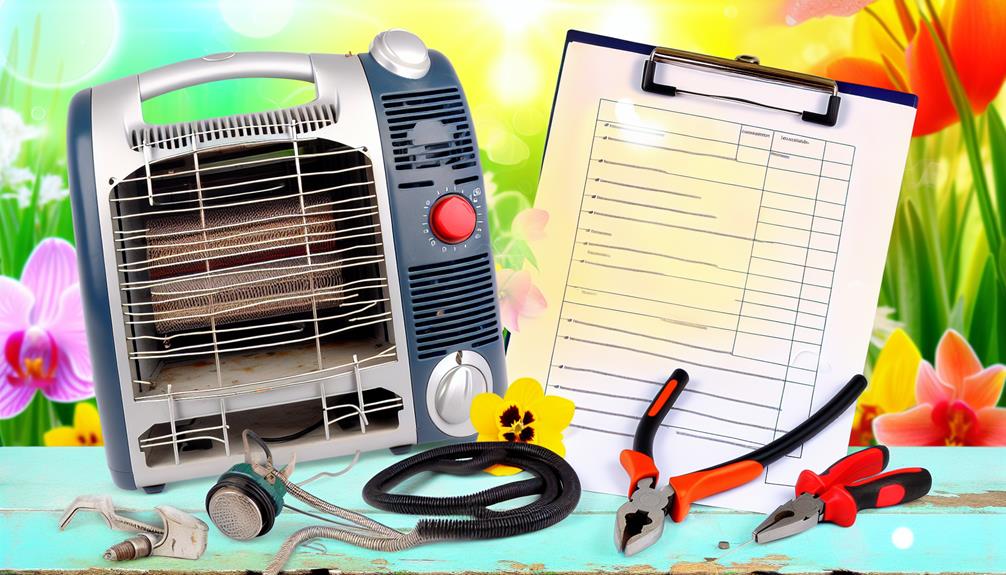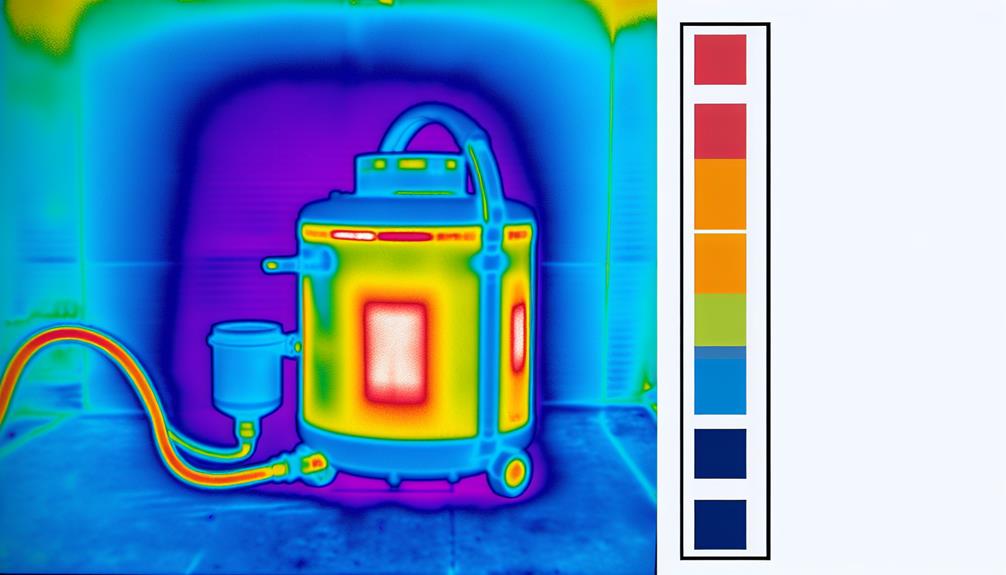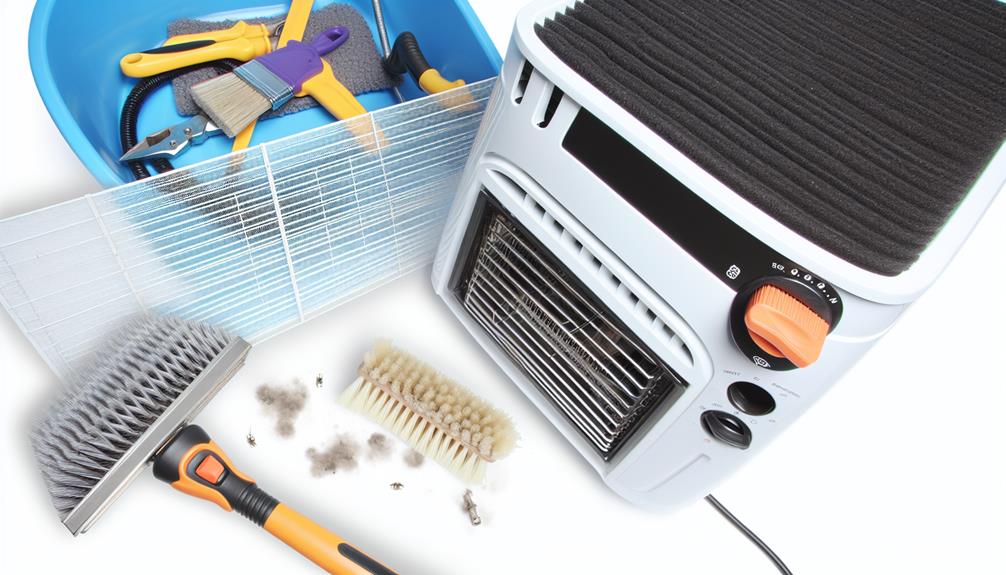Did you know that nearly 80% of home heating equipment breakdowns could have been prevented with regular maintenance? As the chill of winter approaches, it's time to turn your attention to the portable heater that keeps you cozy. You wouldn't want your trusty device to sputter out when you need it most. That's why you need a comprehensive seasonal maintenance checklist tailored for your portable heater. From inspecting filters to testing safety features, each step is crucial in preparing your heater for the demanding months ahead. What you'll find is not just a routine chore, but a series of insightful measures that could significantly extend the life of your heater, enhance its performance, and perhaps more importantly, safeguard your home from preventable hazards. Stick with me, and you'll uncover the essential practices that will keep your warmth uninterrupted and your winter worry-free.
Key Takeaways
- Regularly check and clean filters to prevent clogging and inefficiency.
- Ensure safety mechanisms like automatic shutoff and tip-over protection are functioning correctly.
- Conduct an annual maintenance review, including inspecting filters and testing the thermostat.
- Regularly apply lubricants to ensure optimal performance and extend the lifespan of the heater.
Inspect and Clean Filters
To maintain your portable heater's performance and air quality, regularly check and clean the filters to prevent them from becoming clogged and inefficient. Dirty filters can cause uneven temperatures and unnecessarily high heating bills due to decreased system efficiency. It's paramount to inspect the entire heating system, but pay special attention to the air filters where dust and debris accumulate.
When you clean dirt from the filters, you're not only ensuring proper airflow but also contributing to the longevity of your heater. This routine inspection and cleaning are crucial components of heating system maintenance. To do this effectively, turn off the heater and unplug it for safety before removing the filter. Examine it for dust and debris. If the filter is reusable, use a vacuum to remove loose particles and then wash it gently with warm water, allowing it to dry completely before reinstalling. For non-reusable filters, replace them according to the manufacturer's recommendations.
Test Safety Features
Ensure your portable heater's safety mechanisms, such as automatic shutoff and tip-over protection, are functioning correctly by performing a thorough test before operation. Your heating maintenance checklist isn't complete until you've confirmed that all safety features of your heating equipment are working properly.
Here's how to test safety features effectively:
- Automatic Shutoff: Simulate overheating conditions by obstructing the heater's airflow or running it in a controlled, safe environment where the temperature is slightly higher. The heater should automatically turn off. Be cautious not to actually overheat the unit and follow the manufacturer's guidelines for this test.
- Tip-over Protection: Carefully tilt the heater to an angle where the tip-over switch should engage. The heater must automatically shut down. Ensure the unit is on a stable, level surface when conducting this test to avoid actual damage.
- Emergency Shut-off Switch: Manually trigger the emergency shut-off switch to verify its responsiveness. This switch should cut power to the unit immediately, indicating it's ready to act in case of an emergency.
Additionally, inspect the power cord and plug for wear or damage, which could compromise safety functions. Never operate the heater if these components show signs of deterioration or if any safety feature fails to respond as expected.
Check for Physical Damage

Begin your physical inspection by scrutinizing the heater's surface for dents, cracks, and signs of wear that could compromise its integrity and performance. As part of your seasonal maintenance for portable heating systems, these visual checks are crucial. Examine the equipment's body carefully; even small imperfections can lead to bigger issues down the line. Pay special attention to the heater's exterior, as damage here can be indicative of more severe internal issues.
Next, check to make sure the venting components are not bent or damaged. Proper airflow is essential for efficient operation, and obstructions could not only affect performance but also pose a fire hazard. Ensure that all fans are free of debris and functioning correctly. A clean fan is paramount for maintaining the unit's effectiveness.
Inspect the wiring thoroughly. Loose or exposed wires are a serious safety concern that needs immediate attention. Do not overlook this step as electrical faults are a leading cause of heater-related accidents.
Adhering to these maintenance tips, address any identified physical damage promptly. A well-maintained portable heater is not only more efficient but also safer to operate. Regular checks and timely repairs are key to extending the life of your heating system.
Examine Electrical Cords
Inspect your portable heater's electrical cords carefully for any signs of fraying, cuts, or other damage that could compromise safety and performance. When you examine electrical cords, you're not just ensuring the longevity of your heating system; you're also safeguarding against potential hazards. Here are crucial steps you should take:
- Look for exposed wires that could be a safety risk. These can lead to electrical shocks or become a fire hazard if not addressed promptly.
- Check for signs of overheating or discoloration on the cords. This can indicate that the cord is handling more current than it's designed for, which can strain your heating system and lead to malfunctions.
- Verify that the cords are properly grounded. A lack of proper grounding can significantly increase the risk of electrical shock and should be corrected immediately.
If you find any issues during your maintenance check, it's critical to address them. Worn or damaged cords should be replaced to maintain the safety and functionality of your portable heater. Remember, regular inspection and prompt repair are key to the reliable operation of your heating equipment.
Verify Heating Efficiency

After checking the electrical cords for safety, it's equally important to assess your portable heater's efficiency to confirm it's operating at peak performance and not wasting energy. Regular verification of heating efficiency is a fundamental step in furnace maintenance. This check ensures that the heat exchanger and other critical components function correctly, especially during the winter season when you rely heavily on your portable heater.
To maintain efficiency, conduct an annual maintenance review using the following table as a guide:
| Step | Purpose | Expected Outcome |
|---|---|---|
| Inspect Filters | Ensure proper airflow and air quality | Clean or replace as needed for efficiency |
| Test Thermostat | Confirm accurate temperature regulation | Adjust or repair to maintain performance |
| Examine Heat Exchanger | Detect cracks or leaks | Repair or replace to prevent CO hazards |
| Review Energy Usage | Compare current usage to past seasons | Identify any unusual increases in energy |
Lubricate Moving Parts
You'll first need to identify the lubrication points on your portable heater, such as motor bearings and fan shafts. Select the appropriate lubricants that match the specifications of your heater's components for optimal performance. Apply these lubricants carefully, using techniques that ensure even distribution without over-lubricating, which can attract dirt and cause damage.
Identify Lubrication Points
To ensure your portable heater operates smoothly, regularly lubricate all moving parts, such as fan blades and motor bearings, as part of your maintenance routine. Identifying lubrication points is crucial for the longevity and efficiency of your HVAC system. Here's what to focus on:
- Fan Blades: Check for any points where friction occurs, especially near the central hub, and apply lubricant to reduce wear.
- Motor Bearings: These are often the most critical lubrication points to maintain working order; locate the bearing caps or grease fittings.
- Swing or Tilt Mechanisms: If your heater pivots or oscillates, these joints require lubrication to prevent stiffness or noise.
Seasonal maintenance, including diligent lubrication, ensures your portable heater remains reliable and extends its service life.
Choose Appropriate Lubricants
Having identified the lubrication points on your portable heater, it's crucial to select the appropriate lubricants to ensure the parts operate smoothly and efficiently. Opt for high-quality oils or greases designed for high temperatures and electrical safety. Apply lubricant to motor bearings to maintain their working condition, which prevents overheating and unnecessary strain on the motor. Regularly oil the blower to avert any squeaking sounds that indicate friction or resistance. Check the fan or blower wheel for any signs of damage or binding, and lubricate it carefully to avoid dust and dirt buildup, which can impair function. To make certain you're using the right products and methods, don't hesitate to schedule an appointment with a professional for guidance on your heater's maintenance.
Lubrication Application Techniques
Ensure all moving parts are adequately lubricated by applying high-quality lubricants to areas like motor bearings and fan wheels, following the manufacturer's guidelines for both the quantity and method of application. Proper lubrication is crucial for maintaining your portable heater in good working order, especially during the winter months when central heating systems are under significant strain. It's time to make sure your heater runs smoothly with these techniques:
- Check the motor shaft for free rotation and apply lubricants if you encounter any resistance.
- Inspect the fan or blower wheel for damage. Lubricate it carefully to prevent further wear and tear.
- Regularly apply lubricants to all moving parts to ensure optimal performance and extend the lifespan of your heater.
Review Thermostat Operation
Begin your portable heater maintenance by testing the thermostat; switch it to heating mode and verify that it responds without delay. A responsive thermostat is essential to maintain a warm and comfortable environment throughout the winter. In contrast to air conditioning, where you seek to cool, your portable heater needs to promptly react to maintain your desired temperature.
If you find that the thermostat is sluggish or unresponsive, consider upgrading to a modern unit. Today's thermostats offer improved functionality and enhanced energy efficiency, which can help you stay comfortable while controlling your heating costs.
Make sure to review the operating manual for your thermostat's specific maintenance guidelines and setup instructions. This step is crucial as it ensures you're using the device as intended, preventing unnecessary wear and optimizing performance.
Regularly revisit this manual to familiarize yourself with the correct operation of your thermostat. It's easy to forget small details over time, and a quick refresher can help you avoid mistakes that may affect your heater's efficiency. Remember, a properly functioning thermostat is key to keeping your living space consistently warm during the colder months.
Clear Dust and Debris

To maintain your portable heater's efficiency, regularly clear away any accumulated dust and debris from the burners and surrounding area. Over time, these unwanted particles can impede your heater's performance, potentially leading to a decrease in the air clean and even safety hazards. Taking care of your heater is particularly crucial after the summer months when it's likely been idle.
Here's how to ensure your heater is free from dust and debris:
- Professional Burner Cleaning: While you can tackle surface dust, professional cleaning of the burners is recommended to maintain optimal performance. They have the tools and expertise to thoroughly clean the internal components.
- Vacuum Regularly: Use a vacuum with a soft brush attachment to gently remove dust from the heater's exterior. Extend the vacuuming to the floor and the wall area around the unit to minimize airborne particles that could be drawn into the heater.
- Inspection for Soot: Shine a flashlight onto the burners to check for black soot, which indicates incomplete combustion and possible blockage. If you spot soot, it's time to call a professional for a deeper inspection and cleaning.
Schedule Professional Servicing
Scheduling annual professional servicing for your portable heater is key to maintaining its efficiency, safety, and longevity. By arranging for a technician to inspect your heater, particularly in late summer, you're preparing ahead of the colder months. This preemptive measure can save you from the inconvenience of mid-season breakdowns when you need heating the most.
Professional technicians will thoroughly inspect your heater, looking for any signs of wear or potential safety hazards. They'll also clean components that are often overlooked, ensuring that your unit operates at peak performance. With their expertise, they'll identify parts that may need replacement, preventing future issues that could lead to additional fuel consumption or even a complete system failure.
Don't wait until it's too late. Schedule professional servicing to guarantee that your heater's fuel tank and other vital components are ready to function efficiently throughout the heating season. Here's a quick overview:
| Benefit | Emotion Evoked |
|---|---|
| Ensures Safety | Peace of Mind |
| Extends Heater Lifespan | Confidence in Investment |
| Prevents Costly Repairs | Relief from Financial Worry |
| Enhances Efficiency | Satisfaction with Performance |
Frequently Asked Questions
What Are the Checklist for Space Heaters?
You'll need to check your space heater's placement, ensuring it's away from flammable materials. Conduct a thorough safety inspection for any signs of wear or damage. Examine the cord condition; look for fraying or electrical issues. Clear away dust accumulation, which can pose a fire hazard. Regular attention to these details not only boosts efficiency but also enhances safety, keeping your heater in top shape for when you need it most.
How Do You Service a Heater Before Winter?
To service your heater before winter, start with a thorough heater inspection. Check filters, fuel lines, and connections. Remove dust from internal components to prevent fires. Test your thermostat for accurate temperature control and ensure all safety features are functioning correctly. You'll need to examine different parts depending on your heater type, but these steps are crucial for optimal performance and safety. Don't forget an annual professional check-up for comprehensive maintenance.
How Often Does a Heater Need to Be Serviced?
Just as you wouldn't drive a car endlessly without a check-up, your heater also needs regular servicing. Aim for at least once a year to ensure its lifespan, optimize efficiency, and conduct safety inspections. This routine care is not just about comfort; it's also about warranty considerations. Adhering to a service schedule keeps technical issues at bay and your heater running practically and efficiently throughout the cold months.
What Is Typical Preventive Maintenance Assigned to Heating Equipment?
Typical preventive maintenance for heating equipment includes safety inspections to prevent hazards. You'll want to ensure energy efficiency by checking and possibly upgrading components. Don't forget about airflow testing to verify that your system is operating correctly. These steps are crucial for peak performance and safety. It's practical to schedule this maintenance regularly to avoid unexpected breakdowns and maintain your heater's longevity. Keep an eye on your equipment's health with these proactive measures.
